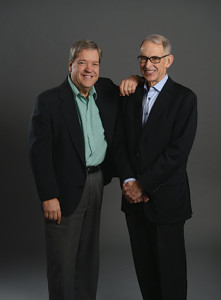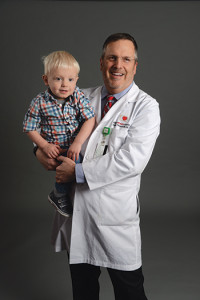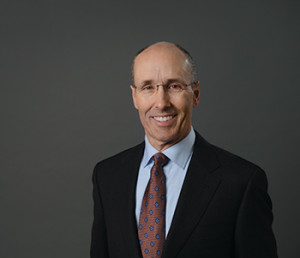Writer: Mary Challender
Photographer: Duane Tinkey
Casual discussions of medicine tend to focus on cost, bureaucracy and the struggle to cure stubborn diseases, making it easy to lose sight of the amazing successes happening every day at local hospitals and clinics. In fact, much of what’s routine today would have seemed miraculous just a few years ago. Meet patients whose lives have been dramatically changed by methods that are both remarkable and routine—and get to know the skillful doctors who made those changes possible.
No-nonsense weight loss

Van Harden + Dr. Sean Cunningham
Longtime WHO radio morning host Van Harden and Des Moines internist Sean Cunningham seemed unlikely to hit it off when they met for the first time last April. Harden weighed 287 pounds and had avoided getting a physical for years because he didn’t see the point of some doctor telling him he needed to lose weight.
Cunningham is known for bluntly spelling out the risks of obesity, including heart damage, dialysis, amputations and eye disease, whether his patients want to hear them or not; he readily acknowledges that most don’t.
The only reason Harden walked through the door of Cunningham’s office at The Iowa Clinic was that he
was scared. A man proud of his ability to work 12-hour days, he was embarrassed to find himself regularly falling asleep at his desk. At 63, he was sure that something was seriously wrong.
Cunningham scheduled tests for his new patient and found that Harden’s blood pressure was high, his cholesterol was high, he was borderline diabetic, and he had a condition called hyperventilation syndrome, in which the size of his body affected the movement of his diaphragm, making sleep difficult.
Cunningham asked Harden to describe his normal eating habits. Harden admitted he normally skipped breakfast and lunch, then ate from the time he got home around 5 p.m. until he fell asleep. Cunningham told Harden what he typically ate: oatmeal with walnuts and raisins for breakfast; yogurt for lunch; fish or chicken with vegetables for dinner and fruit for dessert.
Harden left Cunningham’s office with prescriptions for his cholesterol and blood pressure and went straight to Office Depot to buy a little notebook. On his next visit, he showed Cunningham his new food diary. The doctor flipped through the pages and was stunned to find each page was almost exactly the same: Oatmeal with walnuts and raisins for breakfast, yogurt for lunch, boneless, skinless chicken and vegetables for dinner, with fruit for dessert.
A man who hated exercise, Harden even went along with Cunningham’s edict to walk for a half-hour each day, seeking out high school and college tracks on which to do laps when the weather was nice, then moving inside to big home improvement stores when the snow came.
Harden’s cooperation has paid off. At his most recent visit to Cunningham’s office, Harden weighed in at 196 pounds and thought the scale was broken until he realized he needed to slide one of the 50-pound weights down to a lower setting.
“That was kind of an emotional deal,” he says. “I’ve lost 91 pounds. They’re calling me mini-Van now.”
Harden, who has been able to stop taking most of the medications he was prescribed on that first visit, credits his vastly improved health partly to Cunningham’s great bedside manner. “He was really honest and straightforward, but he wasn’t dour,” Harden says. “And he laughed at my jokes.”
Cunningham agrees he’s a sucker for jokes. And for compliant patients. It gets frustrating for doctors, he says, constantly being called on to deal with the damage patients wreak on their own bodies. Patients like Harden are rare but appreciated, he says: “Having one person like that makes up for everything else.”
Surgical skill, technology save toddler

Kellan Wallenburg + Dr. David Hockmuth
The puckered scars on 2-year-old Kellan Wallenburg’s neck and chest are testament to a battle for survival that began with his first breath.
And to the skilled cardiac surgery team and terrifying machine that saved his life.
Alison Wallenburg says she heard only one cry when Kellan was born on the evening of Oct. 7, 2013. Then doctors and nurses rushed the infant from the room, his father, Jon, following in their wake.
The first-time parents soon learned that their son had severe persistent pulmonary hypertension and a complex heart defect called transposition of the great arteries, in which the two main arteries leaving the heart are reversed, leaving the body starved for oxygen. The condition is correctable through surgery, says Kellan’s cardiothoracic surgeon, David Hockmuth of the Iowa Heart Center. But the challenge is keeping babies with blood oxygen levels as low as Kellan’s alive until then.
When a ventilator failed to stabilize Kellan’s condition, only one option remained: extracorporeal membrane oxygenation, or ECMO, a procedure available in Central Iowa only at Mercy Medical Center, which uses a machine to take over the work of the heart and lungs so they can rest and heal.
Nothing could prepare the Wallenburgs for the sight of their baby on ECMO—a tiny speck of boy wired to a sea of machines. Kellan’s head was turned to the side to reveal two large tubes called cannulas running through blood vessels in his tiny neck. For the first time, Alison and Jon understood that Kellan might not make it.
“If this didn’t work, nothing was going to work,” Alison said.
It worked. After five days, Hockmuth decided to wean Kellan from the procedure so he could perform surgery to correct the heart defect. But instead of tying off the blood vessels in Kellan’s neck as was standard procedure for ECMO patients, Hockmuth decided to repair them,
a procedure he’d seen done before but had never attempted himself.
This decision likely saved her son’s life, Alison says.
Not long after Kellan was removed from ECMO, his parents were called back to the hospital in the middle of the night. Kellan’s organs were failing. The couple were at the hospital when their son’s heart stopped.
Kellan was revived, but it was clear he couldn’t make it on his own. Hockmuth and the ECMO pediatric team rushed to hook the boy back up to the machine, using the just-repaired blood vessels. Then, knowing Kellan would never be strong enough to remove from the machine for surgery, Hockmuth decided to take the unusual step of operating with Kellan still on ECMO.
On Oct. 25, Kellan was finally wheeled into surgery. His parents walked with him all the way to the operating room to say their goodbyes, squeezing his tiny feet and telling him over and over how much they loved him.
“It was hard to let him leave our sight because you don’t know if it’s going to be goodbye forever,” Alison says.
In the operating room, Hockmuth and the cardiac surgery team labored through the day to disconnect and reposition Kellan’s transposed arteries. They were hopeful that the boy would eventually be strong enough to be weaned from ECMO. But Kellan did so well once his arteries were realigned that the doctors removed him from the machine at the end of the surgery.
“Everybody was thrilled and amazed,” Hockmuth says.
Today, Alison says, Kellan’s a typical active, healthy, occasionally naughty 2-year-old who is a source of hope to other parents who have children with Kellan’s condition.
He’s also a welcome sight for a doctor who knows it’s impossible to save every baby born with a heart malfunction, but with the help of ECMO and an experienced team of doctors and nurses, he can give newborns like Kellan a fighting chance.
“I know he likes to see Kellan,” Alison says of Hockmuth. “Who wouldn’t want to see a patient he essentially brought back to life and now is doing so great? That’s his work and something to be proud of.”
Micro-attack on tumor

Virginia Miller + Dr. Andrew Nish
When doctors spotted a 3-inch tumor growing in Virginia Miller’s liver four years ago, the Newton woman didn’t seem to have many good options.
At 82, she didn’t qualify for a transplant, and the type of cancer she had–a malignant hepatoma–was known to be unresponsive to traditional chemotherapy. And surgery wasn’t recommended; the tumor was large and in a location with heavy blood flow, and Miller had a bad heart valve.
Although Miller had no symptoms, her prognosis was grim. Without treatment, her life expectancy was between nine and 14 months.

“You don’t know what to expect,” she says, “and you think the worst. But I guess I was prepared for anything.”
Fortunately, Miller’s oncologist at John Stoddard Cancer Center referred her to a colleague, Dr. Andrew Nish, medical director of the cancer center and a specialist in interventional radiology, a method of performing minimally invasive surgery using imaging tools like X-rays and CT scans as guides.
John Stoddard is one of perhaps 10 medical centers in the country with an interventional radiology room that has both fluoroscopy (traditional X-ray) and CT equipment available in the same room, Nish says. This is a big advantage when it comes to treatments that involve precisely delivering radiation or chemotherapy directly into a tumor.
In Miller’s case, Nish used his expertise in imaging-guided therapies to do a procedure called radioembolization, which involves carefully guiding a catheter through the arteries until it reaches the blood vessels supplying the tumor and then feeding millions of tiny radioactive beads into the catheter.
The procedure was done in two outpatient visits under conscious sedation. The first visit was to map the route through the arteries for the catheter, making sure to avoid blood vessels leading to the bowel where the beads would cause ulcers, Nish says. In the second visit, Nish inserted the catheter and flooded the tumor with the radioactive beads.
Miller went home to Newton later that day and says her only side effect was “a little upset stomach.” Although the treatment caused her tumor to shrink initially, after several months it appeared to be growing again. So Nish decided to repeat the treatment.
This time, Miller says, she made the mistake of eating ice cream on the way home and paid for it. But just one day after the treatment, she felt fine. Even more important, her tumor has shrunk steadily since then, to the point that it’s now just over an inch in diameter and she only has to go in for annual checkups.
“I’ve really been lucky,” she says. “I feel really good. I go out and work in the yard and go out everywhere I want. It doesn’t hold me back.”
Also delighted by the outcome, Nish says it’s pretty “spectacular” that an octogenarian with a large tumor was able to have such a great result without a hospital stay. In general, he tells liver cancer patients that targeted therapies can give them another 30 to 36 months of life. Miller has already surpassed that.
Nish isn’t sure what qualifies as normal life expectancy for an 86-year-old, but he’s willing to make one prediction given the size of Miller’s cancer today: “I don’t think she’ll die from her liver tumor.”
Mary Challender is a freelance journalist and technical writer at DuPont Pioneer. Not all stories can have happy endings, but she enjoys reading and writing ones like these, which do.


